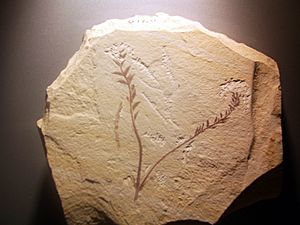Archaefructus facts for kids
Quick facts for kids Archaefructus |
|
|---|---|
 |
|
| Archaefructus liaoningensis - a photograph of a facsimile of the fossil | |
| Scientific classification | |
| Kingdom: | |
| (unranked): | |
| Class: | |
| Family: |
Archaefructaceae
Sun, Ji, Dilcher, Zheng, Nixon & Wang
|
| Genus: |
Archaefructus
Sun, Dilcher, Zheng & Zhou
|
| Species | |
|
Archaefructus eoflora |
|
Archaefructus is a very old type of plant that is now extinct, meaning it no longer exists. Its fossils have been found in China, and they are about 125 million years old! This makes Archaefructus one of the earliest known flowering plants ever discovered.
Contents
What Was Archaefructus?
Archaefructus was a herbaceous (non-woody) aquatic plant. This means it was a soft plant that grew in water. Scientists found its fossils in a place called the Yixian Formation in northeastern China. These fossils date back to the early Cretaceous period.
How Archaefructus Looked
Unlike many modern flowers, Archaefructus did not have sepals or petals. Sepals are the leaf-like parts that protect a flower bud. Petals are the colorful parts that attract pollinators.
Instead, its reproductive parts grew on a long stem. These parts included carpels (the female parts) and stamens (the male parts). In modern angiosperms, these parts are usually grouped together in a compact flower.
A New Plant Family
Because of its unique features, scientists have suggested that Archaefructus belongs to a new plant family. This family is called Archaefructaceae. It is considered a very early or "basal" group of flowering plants.
Different Ideas About Archaefructus
Scientists sometimes have different ideas about how ancient plants looked. One idea is that the long stem of Archaefructus was not a single flower. Instead, it might have been a group of flowers called an inflorescence.
In this idea, the male flowers (with stamens) were lower on the stem. The female flowers (with carpels) were higher up.
New Discoveries
The discovery of a new species, Archaefructus eoflora, helped scientists learn more. This fossil showed a flower that had both male and female parts. This flower was located between the male and female organs on the stem.
This discovery supports the idea that Archaefructus had an inflorescence. If this is true, Archaefructus might be related to plants like Nymphaeales (water lilies) or early eudicots.
See also
 In Spanish: Archaefructus para niños
In Spanish: Archaefructus para niños

